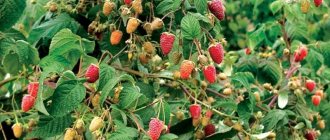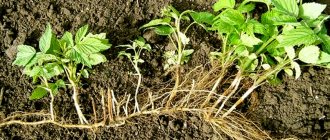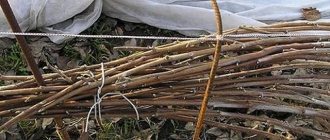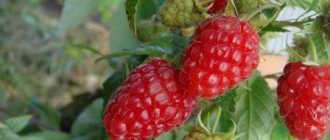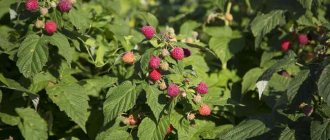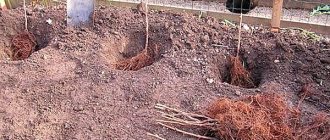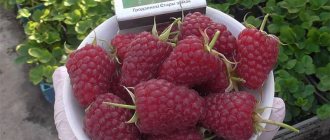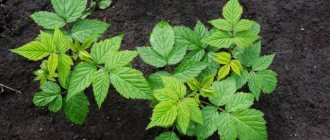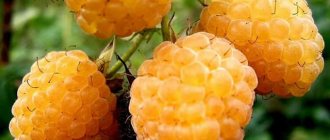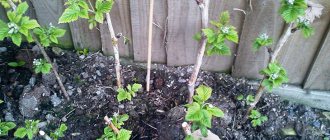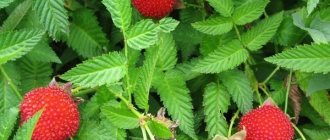Which method should I choose?
The choice of the appropriate option depends on the following factors:
- The soil. On heavy soils, mechanical limitation methods are most effective. On light soil, it is preferable to use agrotechnical and chemical measures.
- Dimensions of the plot. Joint planting with competitive crops (especially weeds) requires sufficient area. One raspberry bush will require at least 2 sq.m. free space. Therefore, in front gardens and small gardens it is best to use barriers.
- Availability of resources. Not every gardener can boast of a sufficient amount of free time allocated for complete pruning of raspberries. Purchasing slate or film will require significant financial investments, and digging a trench to lay them will take a lot of physical effort. Suitable fertilizers are not always available, especially in areas remote from the city.
Which method of “taming” raspberries to choose depends on the capabilities and desires of the gardener. As practice shows, the best results can be achieved by combining several methods.
All summer residents plant raspberries, but if the necessary measures are not taken immediately when planting the bushes, very soon the berry bush will take over the adjacent areas of the garden. And then the pressing question arises: what needs to be done to prevent the raspberries from spreading throughout the area. In this case, experienced gardeners take several measures to protect the dacha from “unauthorized seizure.”
Ways to combat regrowth
There are several methods of combating growth:
- Mechanical. It is necessary to install metal plates 45-50 cm wide along the perimeter of the raspberry bushes. Deepen them into the soil by 40 cm to prevent the development of adventitious roots - they will be able to grow in breadth, but more slowly. Without sunlight they will be weaker. The disadvantage of this method is the difficulty in removing the germs of shoots located in the ground.
- Biological. It involves planting some crops next to raspberries. Winter varieties of garlic, sorrel and beans are suitable. The shoots will grow much worse and will almost stop appearing.
- Chemical. Raspberries are irrigated with herbicides in the spring. The method involves spending money, but is very convenient for a large number of bushes.
Proper removal of growth and pruning of bushes will help increase their productivity. The lifespan of plants will be significantly extended. All of the above is true only for ordinary garden raspberries. The advice is not suitable for increasing the productivity of a remontant plant variety.
Reasons why raspberries grow
Raspberries are a well-known garden egoist when it comes to moisture consumption. Therefore, it is difficult for many crops to grow next to bushes, especially low-growing ones. The point is the root system, which, in addition to the base, has an extensive system of adventitious processes. It is a very branched stem with buds. From these, shoots subsequently develop above the ground.
The depth of the raspberry root system is small:
- in sandy soils - no more than a couple of meters;
- in clayey ones - less than 0.6 m.
In this case, a significant part of the root is located at a depth of no more than 10-50 cm. The branching radius of the underground stem of one shrub can be up to 2 m. With such data, it is easy for raspberries to take moisture from weaker plants in the adjacent area. The adventitious roots do not grow continuously. The process depends on soil temperature and humidity. In moderate heat, the root will grow better (and, as a result, produce more shoots), and with a high level of soil heating, the plant will actively develop the above-ground part. Gardeners use this feature to control the development of raspberries.
Advice. Mulching is used to maintain high soil temperatures. Together with the application of organic fertilizers, this measure will help to curb the excessive development of adventitious roots.
This is interesting: Where strawberries grow in the Moscow region: what you need to know
How to choose the best varieties
As for varieties, you can choose one of the main types:
- classic, with a two-year shoot development cycle;
- standard;
- remontant.
Unlike classic varieties, remontant varieties bear fruit twice a year. The first time - in July on the shoots of the previous year, and the second time - from August to October, depending on the variety.
Important! The most important feature of remontant varieties is the absence of the raspberry beetle, which affects classic raspberries. The reason for this is very simple - the beetle’s development cycle ends before fruiting begins.
An additional difference between classic and remontant varieties is that the classic ones need to be prepared for the winter and mounted on a trellis during the growing season. And the repair room does not need these operations. Varieties such as Atlant, King Penguin, Yellow Penguin, Eurasia are excellent at holding a large harvest. If you doubt the taste, then the varieties Caramel, Autumn Beauty, Himbo-Top are superior in sugar content to their classic relatives.
The best remontant varieties:
When choosing, pay attention to the group of Penguins - they are able to provide a harvest even in the conditions of a very short summer beyond the Urals. In addition, the bushes do not freeze and can withstand frosts down to -30°C
We can say that the variety justifies its name 100%.
Atlas is very interesting. One bush of this variety will provide you with a harvest of 6-7 kg, and 20 bushes - up to 120-130 kg over the summer. They do not require support and are disease resistant, making them best for commercial cultivation.
The Orange Miracle variety is a beautiful orange berry with high organoleptic properties. The variety is not characterized by high yield, but children are happy to buy such berries. In addition, you can even grow the bushes themselves for sale - they are planted near gazebos due to their excellent decorative properties.
Hercules is a very productive variety (4–5 kg of berries per bush), requiring a trellis. Its advantage is its excellent adaptability to different types of soil. Fruiting is stable even with poor agricultural technology. The berries are large in size and have a slightly sour taste.
Standard raspberries are known to many under the name “raspberry tree”. It is a single shoot on which branches of the 2nd order are formed. As a result, the bush becomes like a tree. These plants look very attractive. They do not need shelter for wintering and are disease resistant. The yield of one plant is 5 kg, which is higher than that of most remontant varieties. Plant height is 120–140 cm. Caring for standard raspberries is quite simple, as is harvesting
But remember that you will need to pay attention to the formation of the bush and pinching the tops of the shoots.
Did you know? The phytonutrients found in raspberries may be effective in treating high blood pressure and joint inflammation. They also have a beneficial effect on liver function.
The main standard varieties of raspberries:
- Medium late Tarusa with berries weighing up to 15 g. It ripens from mid-July to mid-August. The bush reaches a height of 1.7 m. To get maximum yield, it is recommended to leave 7–10 shoots on the main trunk and trim the rest. This will help avoid thickening. The yield of the variety is up to 4 kg of berries per bush. The variety is susceptible to attacks by pests, but it is able to produce a harvest even in the presence of a moderate degree of infestation. Can grow in dry climates, maintaining productivity.
- The Skazka variety lives up to its name with a yield of up to 10 kg per bush. Main characteristics: excellent keeping quality, high taste, ultra-high yield, resistance to diseases and pests.
Errors in soil preparation
- Incorrect site selected. Raspberries develop well when located in the sun or partial shade. The shadow negatively affects the amount of harvested crop. In addition, the lack of sufficient light leads to the berries becoming smaller;
- Planting on clay soils. Why do raspberries grow poorly in such soils? Clay is not only heavy, dense soil. It causes water stagnation. Raspberry does not like such conditions. Therefore, you should not choose a clay area. If there are no other options, then you need to do thorough work to change the structure of the soil: add drainage, mulch with light soils, loosen the soil well, dig up the area in the fall;
- Uncontrolled plantings. Raspberries grow very quickly. Small shoots take a lot of energy and nutrients, but do not produce a decent harvest. In addition, an overgrown area is difficult to process. Therefore, you need to monitor the growth of raspberries and constantly remove excess shoots;
- Unregulated soil acidity. Every gardener who wants to get a good raspberry harvest should carry out the procedure for determining acidity. In addition, acidified soils are a favorable environment for the development of fungal diseases;
- Planting raspberries in an old uprooted plot is a gross mistake by gardeners. In the old place, after removing the bushes and roots, all diseases and pests remain, the soils are depleted, which is why new raspberries do not take root on the site. You can plant a raspberry tree in the place of the old one no earlier than after 6 years.
Raspberries, like remontant strawberries and grapes, have special requirements for soil quality. To get a good harvest, you need to prepare thoroughly: study the composition of the soil, analyze its structure, and, based on the collected data, take measures to improve the quality of the soil. Compliance with soil acidity and moisture standards, as well as timely fertilizing will give excellent results.
Ways to keep raspberries from spreading
Raspberry shoots primarily harm the raspberry itself, taking nutrients from the fruiting bushes. It is better to cut off the shoots immediately after they appear, and do it as deep as possible. However, even so, manually, it is difficult to stop the growth of raspberries. The more shoots you remove, the more they are formed.
Prevent raspberry shoots from growing overgrown
The abundant formation of overgrowth can be mechanically limited by underground fencing. As a rule, sheets of metal or slate are dug into the ground for these purposes. Fortunately, you don’t have to dig deep. Above the ground, the damper may be almost invisible.
If such a measure is not available, then agricultural technologies will come to the rescue. Some types of garden and weed crops planted along the perimeter of the bush have a barrier effect on raspberries:
- Cereal or asparagus beans, bush forms are better. The roots of these crops release substances into the soil that prevent the growth of the underground part of the raspberry.
- Sorrel. The perennial plant saturates the soil with tannins, which stop the growth of raspberry shoots. For a visible effect, the bed should encircle the raspberry tree in 2-3 rows. The total thickness of the plantings should be at least half a meter. Sorrel is not picky about care, but loves fertile soil.
- Parsley, garlic, radish.
- Metlitsa. This is the case when weeds come to the aid of the gardener. This annual plant has a strong and branched root. It grows easily next to a raspberry tree. In addition, the grass thickly covers the area, helping to retain moisture in the soil.
Attention! Despite its weedy origin, broom has recently been often used as lawn grass and in landscape design.
How to limit sprawl?
Without artificial restriction, raspberries will inevitably take over the entire area over time.
Shrub suppression methods can be divided into 3 groups:
- Mechanical: selective uprooting, installation of barrier structures, sanitary pruning.
- Chemical: applying fertilizers that redirect the plant’s forces from the development of the root system to the growth of the above-ground part.
- Agrotechnical: joint planting with crops that limit the growth of raspberries.
Trimming
Timely pruning prevents excessive spreading of the raspberry tree. It is carried out in early spring or late autumn.
Perform pruning in stages:
- Mow down all the growth in the raspberry field.
- Remove old shoots from the mother plant. Usually there are 7-10 of them.
- Young stems are shortened and dried shoots are cut off.
Important! In a neglected area, pruning can only provoke the formation of new growth. The only way out in this case is total uprooting.
Fencing with barriers
The easiest way to limit raspberries physically is to fence off the raspberry tree, not allowing the roots to go beyond certain boundaries. Another option is to limit each bush individually by building a barrier within a 1 meter radius of the rhizome. The created fence must be solid (without cracks or holes) and buried 40-60 cm into the ground.
The following is used as a barrier:
- Slate. The sheets are installed with an overlap of 15 cm to ensure a tight connection. The advantage of a slate fence is that, by suppressing the growth of shrubs, it serves as a decorative object. For example, from recessed slate you can form a neat fence 30-50 cm high.
- Sheet metal. It is installed on the same principle as slate, but compared to the latter, metal has a significant drawback - corrosion. The dug-in galvanization will rot within 2-4 years, after which the fence will need to be reinstalled.
- Polyethylene. Pieces of cellophane or film are placed in dug trenches with an overlap of at least 20 cm. This limits the growth of raspberries for 3-5 years.
Reference! The best option for a cellophane barrier is a roofing water barrier. In addition to the fact that the film is reinforced with fabric fiber, it is sold in rolls up to 50 meters long, which is convenient for laying around the perimeter of the site.
Nitrogen fertilization
Nitrogen stimulates the growth of green mass. An increase in its soil concentration can stop the development of the root system and redirect the shrub’s forces to the formation of leaves and shoots. This occurs in April-May and September-October - the active phases of root growth. However, adding nitrogen during the summer months can have a negative impact on yields.
The following fertilizers will help fill the soil with nitrogen:
- Urea (urea). Highly effective fertilizer containing about 46% nitrogen. The permissible concentration of the solution is 50 grams/10 liters of water. Apply 2-4 liters of mixture per 1 sq.m of raspberry bush.
- Ammonium nitrate. Contains 35% nitrogen. It can be applied as a separate fertilizer or as part of a complex fertilizer. A characteristic feature of ammonium nitrate is that it is quickly washed away by moisture, so it should only be applied to dry soil. Consumption rate – 10-30 grams/sq.m.
- Ammonium sulfate (20% pure nitrogen). Suitable for complex feeding, but does not combine well with alkaline components. 30-40 grams of the substance are added per 1 sq.m of raspberry bush.
- Calcium nitrate (15% nitrogen). Before applying fertilizer, the lumps must be thoroughly crushed to improve absorption. The consumption of the substance is 30-50 grams/sq.m.
Attention! Nitrogen compounds strongly acidify the area. After such fertilizing, it is necessary to deoxidize the soil with chalk, lime or dolomite flour.
Use of agricultural technologies
Another popular method of limiting a berry garden is to plant competing plants along its perimeter. Their roots saturate the soil with waste products, which prevent the roots from spreading throughout the area.
Such plants include:
- Sorrel. Releases tannins into the soil that are unfavorable for raspberries. To achieve the desired effect, the width of the sorrel bed must be at least 50 cm (when planted in 3 rows).
- Metlitsa. This weed has a dense and branched root system that successfully suppresses raspberry roots. As a bonus, the broom can give the berry plant a decorative look.
- Garlic. In order to enclose raspberries, garlic should be sown in 2-3 continuous lines.
How to plant raspberries correctly - video
Not long ago I learned that before planting a tree or shrub in the garden, you need to study information about the compatibility of this crop with others, whether they can be planted next to each other. It turns out that the compatibility of fruit trees and shrubs must be observed. Without knowing some of the peculiarities of the coexistence of plants, you can inadvertently harm your garden. If the mistake of planting unfriendly vegetables next to each other can be corrected next spring, then this will be much more difficult to do with fruit trees or berry bushes.
What reasons could there be for the incompatibility of trees and shrubs growing nearby? First, some plants have roots that are located at the same depth. In this case, they will interfere with each other. Secondly, there are plants that secrete certain substances into the soil that suppress the development of others. There are other reasons too.
One piece of advice: before planting a seedling, check the information about the compatibility of plants as neighbors in the garden.
On a note
- You can’t plant bird cherry in the garden - glass pods will fly onto it from all over the area, which will then move on to other fruit and berry plants.
- Hawthorn attracts apple tree pests to the area.
- Buckthorn is a breeding ground for glass rust.
- Not a single plant can tolerate the proximity of fennel and hyssop, so they must be planted in the farthest corner of the garden.
- Some vegetable plants just can't get along if they grow together. By planting them nearby, you can lose a significant part of the harvest.
Physical uprooting
Physical removal of sea buckthorn is the most labor-intensive and complex process of preventing its further growth. The war against sea buckthorn thickets usually begins in early spring, using a shovel and rake for this purpose.
Cutting sea buckthorn: a - incorrect; b - correct.
The main task when physically uprooting a crop is to remove all the roots of the plant from the soil, which can be a very difficult task if the tree is grown for a long time. If you don’t need sea buckthorn at all, then it’s worth cutting out the above-ground shoots, after which it will be much easier to dig up and then uproot the main part of the rhizome.
Important! Simply cutting off the roots with pruning shears and leaving most of them in the ground will not get rid of the crop. Very soon, new root shoots will appear from the shoots existing in the soil and the procedure will have to be repeated.
Features of installing limiters when planting crops
Despite the fact that many people neglect specific care for raspberries, the installation of growth limiters for shrubs should be done during planting. This will best protect the vegetable crops adjacent to the raspberries, and will also help preserve the decorative appearance of the raspberries. To do this, at the planting site, along the perimeter of the planting hole, you should create a complete trench with a depth of at least 30 cm and a width of about 20 cm, in which fencing material should be installed before planting the shrubs.
Important! The fence must be complete; even through a small hole, the roots can spread outward and produce new root cuttings.
Plantings can be fenced with almost any material that can sustainably withstand the effects of chemically active compounds in the soil for many years. You can make a high-quality fence using:
- slate;
- metal sheets;
- dense polyethylene;
- sheets of plastic or any other artificial material.
Enrichment of soil with fertilizers
After studying the pH of the soil, gardeners can change this value. If acidification is the goal, there are different types of mineral fertilizers, especially those with added sulfur. Composting made from green manure and plant residues produces a similar effect.
Deoxidation usually needs to be done every 4 to 6 years because heavy use gradually lowers the soil's pH level. The most commonly used method for this is liming. On heavy soils the procedure can be repeated even several times. The best time to do this would be after harvest or just before sowing.
Important! Farmers need to know that plants cannot always be planted or sown immediately after liming. If you plan to plant quickly, it is better to carry out the deoxidation procedure using an aqueous solution of slaked lime.
Another method, somewhat unconventional, for deoxidation may be the introduction of lime,
How to water raspberries and fertilize bushes
Another important aspect of how to properly care for raspberries is watering the plants. During the summer, depending on weather conditions, from three to five waterings are done at approximately the following times: the first - at the end of May, the second - in mid-June, the third - at the beginning of July, the fourth - at the end of July or early August and the fifth - in October .
Raspberries need to be watered as abundantly as possible - surface watering is excluded. The soil under the plants should be moistened to the depth of the main roots - 15-20 cm. It is impossible to be late with post-harvest (fourth) watering, otherwise plant growth will be delayed, the wood will not ripen well and the winter hardiness of the plants will decrease.
Oktyabrsky - pre-winter - watering is carried out in order to create favorable conditions for overwintering raspberries.
Fertilizing raspberries is another important agrotechnical technique for successfully growing shrubs. For proper planting, care and propagation of raspberries, when preparing the soil for a raspberry garden, 1 bucket of humus or compost, 300 g of wood ash and 80-100 g of phosphorus-potassium fertilizers are added per 1 m2.
On young plantings in the first years, you can limit yourself to feeding raspberry bushes with organic fertilizers, which are applied in early spring and autumn in the form of mulch, and in the summer in the form of fermented mullein infusion or bird droppings.
On fruit-bearing plantings, humus or well-rotted compost can be used for fertilizing at the rate of 5-6 kg per 1 m2 of area occupied by plants. In the spring, nitrogen fertilizing is necessary 1-2 times (15-20 g of urea or ammonium nitrate per 1 m2), then before flowering and after harvesting, apply 60-80 g of complex fertilizer (Nitroammofoska or any organo-mineral) per 1 m2; in the fall, 2-3 weeks before the end of the growing season, give phosphorus-potassium fertilizer. The dose of fertilizer is adjusted in accordance with the growth rate of the bushes and the yield.
It is also useful to use liquid fertilizing with a complete mineral water-soluble fertilizer (“Sortvorin”, “Aquarin” or “Agrolux” as per the instructions) for root watering and foliar spraying.
Root depth
The roots of the plant go shallow into the ground and are located in the arable soil layer - at a depth of 25-30 cm within a radius of 30-60 cm, while the bulk lies at a distance of 10-30 cm from the surface.
The depth of raspberry roots depends on three factors:
- crop varieties;
- growing conditions;
- soil composition.
Depending on the type and structure of the soil, root penetration varies and reaches:
- on sandy soils - 100-150 cm;
- in clayey ones - 40-60 cm.
The growth of the root system depends on:
- from the raspberry variety;
- depth of roots;
- features of agricultural technology.
The roots of the plant stop growing:
- in dense soil;
- with excessive watering or wet soil;
- in conditions of insufficient aeration.
The above-ground part of the culture lives for 2 years, the underground - for many years. Only the mother bush has a tap root; in daughter plants it is formed from appendages. A root system is formed from the stem, and the bush spreads across the nearby area.
Apple tree compatibility - what can be planted next to them
These fruit trees can get along with almost any type of garden crops. An apple tree does not require much space, and there is still enough space under the tree canopies to arrange the beds. To ensure that there are fewer voids in the area, you can create a flower garden on the tree trunks and plant useful herbs. For example, dill and calendula will feel very good next to an apple tree.
In addition to the beneficial natural properties of these plants, they do an excellent job of repelling pests.
On the side of the garden where the sun warms the ground well enough, you can grow tomatoes under the apple tree, the smell of the leaves of which will repel codling moth butterflies. Such a neighborhood is not only useful, but also saves space.
An interesting and mutually beneficial neighborhood can result from planting one or two coniferous or deciduous trees in an apple orchard. Fruit trees in such a neighborhood develop quickly and bear fruit abundantly.
But you shouldn’t plant rowan next to an apple tree. This culture, as scientists found out at the beginning of the 20th century, has no place in an orchard. Because of this proximity, the crop becomes wormy. The cause is the caterpillars of the rowan moth, which damage apples.
Planting raspberry and blackberry roots in spring
I usually start spring forcing in February-March, because... buds on the roots begin to germinate already at a minimum positive temperature.
It is believed that a bud that has begun to grow secretes an inhibitor, i.e. a substance that suppresses the awakening of neighboring buds, so it is better to cut the uterine root into pieces of about 7-10 cm. This breaks the connection between the buds, stimulates their awakening and the formation of new ones, and it is more convenient to work with short roots in the future. However, you shouldn’t grind it completely, otherwise there will be less plastic substances left in the root to feed the shoot.
Experts advise treating the root with a fungicide or at least a solution of potassium permanganate before planting. I do that too. Next, I lay out the root sections on a layer of peat or peat mixture consisting of peat, agroperlite and some potash fertilizer, sprinkle 5-7 cm thick peat on top and water it abundantly. To reduce evaporation, I cover the container with film, first piercing it to minimize “breathing.”
At room temperature and sufficient humidity, the buds quickly begin to grow. “Nettles” appear above the surface of the peat - young shoots, sparse at first, then almost like a continuous carpet.
At this stage, it is recommended to maintain a semblance of a “tropical” microclimate for at least several days, which in greenhouse conditions is achieved by spraying a water suspension using a fogging system. In the grow box, it is enough to spray lukewarm water with a spray bottle 2-3 times a day. I would especially like to note that not all raspberry varieties like sprinkling; at the slightest rotting of the leaves, watering should be stopped. Blackberries, as a stronger and more aggressive plant, are extremely responsive to water treatments.
As soon as the shoots reach 5-7 cm, they are transplanted into separate pots for rooting. There are two ways to transplant
At first, you need to carefully rake out the peat and, having reached the root, cut it off on both sides of the stem and, together with a fragment of the root, plant it in a new place
In the second method, the stem of the “nettle” is grabbed with your fingers as close to the base as possible, then pulled up and at the same time to the side. The shoot will separate from the root with a so-called “heel” - a thickening at the junction with the root. The second method is practiced with a large number of shoots. By the way, 1 kg of mother root of some raspberry varieties can produce from 500 to 1000 seedlings.
I prefer to transplant a shoot bud or shoot into a glass at the very beginning stage. To do this, the roots of raspberries and blackberries must be placed not in peat, but in damp sphagnum moss. It hardly compacts when used, and it is easier to track and select buds ready for germination.
Traditional medicine recipes
There are a large number of recipes that make it easy to prepare medicinal remedies based on raspberry root at home.
Recipe No. 1
average
Napar for inflammation of the lymph nodes
To cure inflammation in the area of the lymph nodes, it is advisable to use steam. It is prepared using medicinal ingredients, which are not difficult to find.
1 10 min. excluding evaporation
Steps2 ingredients
- fir branches
30 g - raspberry root
50 g
Nutritional and energy value per 100 g: Calories 20 kcal
Proteins 5 g
Fat 2 g
Carbohydrates 10 g
- Place all ingredients in a common bowl.
- Pour in warm water until the liquid covers them by 2 cm.
- Place on low heat and cook for 9 hours.
- Let the mixture sit and cool for 12 hours.
- Place in the refrigerator.
The method of use is simple. You need to take 1 tbsp. l. balm 3-4 times a day.
Also learn about the beneficial properties of raspberry leaf tea.
Recipe No. 2
easily
Decoction for the treatment of otitis
If you have signs of otitis media, you don’t have to run to the pharmacy and buy expensive medications. It is enough to prepare an effective remedy at home.
10 min. excluding insistence
Steps2 ingredients
- raspberry root
100 g - filtered water
300 ml
Nutritional and energy value per 100 g: Calories 3 kcal
Proteins 0 g
Fat 0 g
Carbohydrates 3 g
- Place the root in a bowl and rinse under running water.
- Pour in 300 ml of warm water.
- Leave for 5 hours.
- Store in the refrigerator on the bottom shelf.
The course of treatment must last at least 30 days. Drink 100 ml of decoction every day.
Important! Drink the decoction on an empty stomach. This way all the beneficial components will penetrate into the cells of the body.
For colds and coughs
If signs of a cold or cough appear, inhalation is necessary. It is not necessary to re-prepare the solution whose vapor you will inhale. You can use a decoction that is used to treat otitis media.
Pour the decoction into the teapot and remove the lid. Lean over the steam and cover yourself with a bath towel. The procedure is carried out before bed, after which they are tightly wrapped in a duvet. The more you sweat, the faster your recovery will come.
Recipe No. 3
easily
Antipyretic tea
During inflammatory processes in the body, a person’s body temperature rises. If it is not brought down in time, it can lead to death. Tea made from the root system of raspberries helps to get rid of body aches and fever.
0.5 l2 min. excluding insistence
Steps2 ingredients
- raspberry root
5 branches - filtered water
500 ml
Nutritional and energy value per 100 g: Calories 2 kcal
Proteins 0 g
Fat 0 g
Carbohydrates 1 g
- Rinse the roots under warm running water.
- Place in a bowl and pour boiling water over it.
- Let the mixture sit for 30–40 minutes.
Drink antipyretic tea when you notice bouts of weakness. Literally 100 ml of infusion before bed will reduce heat in the body and make you sleep better.
You will also be interested in learning about the benefits and harms of dried and frozen raspberries.
Recipe No. 4
easily
Mosquito bite tincture
In the summer, people suffer from insect bites. To relieve pain and irritation from mosquito bites, you need to lubricate the affected area with the prepared tincture.
1 l 10 min. excluding insistence
Steps2 ingredients
- raspberry root
10 roots - vodka
1 l
Nutritional and energy value per 100 g: Calories 1 kcal
Proteins 0 g
Fat 0 g
Carbohydrates 0 g
- Rinse the raspberry roots. Can be used as a supplement, stems and leaves.
- Pour in 1 liter of vodka.
- The tincture should infuse for 12 hours.
Important! Lubricate the affected areas immediately after the bite. Otherwise, the tincture will take longer to act than it should.
Recipe No. 5
easily
For joint pain
If a person leads a sedentary lifestyle, sooner or later he will suffer from joint pain. This problem is relevant in old age, so many try to use traditional medicine so as not to spend money on medicine.
250 ml5 min. excluding insistence
Steps2 ingredients
- raspberry root
2 tbsp. l. - boiled water
250 ml
Nutritional and energy value per 100 g: Calories 1 kcal
Proteins 0 g
Fat 0 g
Carbohydrates 0 g
- Rinse the root system.
- Pour 250 ml of boiling water.
- The mixture should infuse for 20 minutes.
You need to drink the tincture 3 times a day, 100 ml. Try to drink on an empty stomach for the first time so that the body begins to recover. In the evening, drink 30–40 minutes before. before sleep.
Root suckers
The simplest and most reliable way is to propagate raspberries by root suckers - young shoots grown from adventitious buds of the rhizome. By the end of the vegetative period, the adventitious shoot has its own root system and is ready for independent life. They can be taken either from fruit-bearing bushes or special queen cells can be prepared for transplantation.
Spring planting
By mid-April, raspberry shoots reach a size of 10–15 cm. From this time on, they can be planted. The bush is carefully dug up with a lump of earth so as not to injure the root system, and planted immediately. The planting depth is the same as that of the mother plant, the soil is enriched with humus, potassium and phosphorus fertilizers. After planting, the seedlings need to be watered and mulched abundantly.
When planting raspberries in May, when the branches have grown half a meter or more, be sure to cut them almost to the ground. It is enough to leave 15–20 cm, because the main development will come from the dormant buds of the rhizome. If this is not done, the bush will try to preserve the branch, it may bear fruit, but will not form replacement shoots the next year.
Autumn planting
In autumn, raspberries are planted before the leaves begin to fall, from the second half of September, so that they take root before the onset of frost.
Prepare the bed in advance. At the bottom of the trench, plant debris and small branches are placed on the bayonet of a shovel. A layer of rotted manure or vegetable compost is poured on top, and potassium and phosphorus fertilizer is applied at the rate of 25–30 g per 1 m². The organic pad is covered with garden soil.
From dug up raspberry shoots, root suckers with a large number of fibrous roots are selected for propagation. Long branches are cut to 20–25 cm; for a small shoot, it is enough to pinch off the top to stimulate the release of nutrition to the stem. In spring, old branches will be replaced by young shoots.
Other technologies for breeding raspberries are also known - by seeds, layering, and dividing the bush. But many years of horticultural practice show that the best methods are propagation by root shoots and cuttings.
Description of raspberry roots
Features of berry crop:
- has no central trunk;
- reproduces like a weed;
- has one root for all shoots.
This structure helps the shrub adapt to different soils and climate conditions. Rapid propagation of raspberries is achieved due to the number of root shoots. The length of the underground stem of the plant is 1.5-2 m, in remontant species - up to 4 m. The formation of the root system begins from it, and the shrub grows throughout the territory.
Features of the root system of the shrub:
- the appearance of a bud up to 2 mm in diameter from 95-97% of the underground stem;
- enlargement of the root in places where shoots form;
- formation of shoots from buds in the ground.
Plant propagation begins at air temperature +9…+10°C. During the day, the shoots increase in length from 0.3-0.5 to 3-4 cm. By the flowering period, the process stops.
The second wave of crop growth ends in late summer - early autumn. At the same time, the young stems of the bush increase in volume.
The reproduction process looks like this:
- The grown offspring acquires a root and a stem.
- The next year, fruit branches, 2-3 replacement shoots and daughter shoots appear on it. By autumn, the offspring grows a root, and it forms into an independent bush. By the end of the second year, the raspberry bush consists of annual and biennial plants that have the same root system.
- In the third year, branches grow on the mother and daughter shoots, and replacement shoots grow on the rhizome. The number of leaf formation points affects how much crops will be harvested next year.
We recommend that you read Gooseberry Neighbors in the Garden
Every year this process is repeated. Every season the bush grows, acquiring new shoots. After the death of the mother root, the plant is divided into groups that continue independent development.
Harvest and storage
Raspberries will give an excellent harvest in the third year after planting. Remontant varieties bear fruit in the second year. At maturity, one bush produces a harvest of about 4–6 kg, depending on the variety. Due to their extremely short shelf life, the berries should be picked as early as possible. Once they start to ripen, you will have to pick them every day.
A good berry should be dense, evenly colored, free from insects and rot. If you handle the harvest carefully, the berries will be in good condition for several days (up to 5). Due to their fragility, they must be collected and packaged in plastic containers without further sorting. Collection frequency: 1 time every 3 days. You can draw up a schedule taking into account weather changes and complete all issues related to the sale of products before harvesting.
Proper harvesting is very important if you want to maximize your income. Berries brought from the field must be cooled
This is important for further transportation. Schedule berry picking for early morning: this way you will get them more chilled and this will increase their shelf life
Ripe raspberries are easy to pick from the bush one berry at a time.
Tara
Purchase containers taking into account the buyer's requirements. Thus, any type of packaging is suitable for sale on the market: plastic containers, birch bark boxes, boxes, boxes. The container volume should be designed for 250–400 g of berries. They will not crush each other during transportation. Enterprises that process raspberries and large stores allow packaging in larger containers - up to 1 kg.
Did you know? The average raspberry contains from 100 to 120 seeds.
Implementation
Main sales channels:
- wholesale markets;
- the shops;
- retailers;
- processing plants.
Since raspberries are a perishable product, the issue of marketing the products must be resolved quite quickly. There are two main transportation options: either the farmer delivers the berries to the buyer, or offers self-pickup of already packaged goods. Processing enterprises are supplied with both fresh and frozen fruits. And this allows us to resolve the issue with that part of the product that was not sold in a timely manner.
Category: “Questions and answers
Question No. 1. What to add to the soil for raspberries to prevent pests?
When pruning raspberries in autumn, you must remove all dry leaves and shoots and burn them, as pests have settled under them. Treat the bush and the soil underneath with an infusion of marigolds or wormwood at the rate of 200 g of crushed substance per 10 liters of water. The infusion is kept for 2 days and the raspberries are sprayed.
In the spring, when the raspberries are open after wintering, the bushes are treated for prevention with a broad-spectrum insecticide, for example, fufanol. For fungal diseases, copper sulfate or Bordeaux mixture is most often used. Raspberry galitsa cannot be defeated by anything. She is in the middle of an escape and no means can reach her. Shoots with characteristic thickenings should be cut off and burned.
Question No. 2. How to prepare waterlogged soil for planting raspberries?
- Method 1. Drain the area using drainage.
- Method 2. In the area where raspberries are planned to be planted, build a box 50 cm high and pour fertile soil into it.
Question No. 3. Is there a difference in soil care in spring, summer, and autumn?
The composition of fertilizers changes in different seasons. In spring you need more nitrogen, in summer potassium, in autumn phosphorus. The percentage of NPK elements varies in the composition of complex fertilizers depending on the time of year.
Raspberry root system: structure and care
→ Shrubs → Raspberry root system: structure and care
The growth and development of plants primarily depends on the state of their root system.
The strength of the roots and their health allow fruit bushes to survive in difficult climatic conditions. Each type of garden crop has different features of the structure of rhizomes and their development.
Knowledge about them will allow you to choose those methods of growing shrubs that will contribute to the flowering and active fruiting of the plant.
When gardeners begin to dig up old raspberry bushes, they pay attention to the rhizome of the bush. It connects young shoots with old plants, entangling the entire area with its strong twists
It’s not for nothing that in neglected gardens, raspberries fill the entire space like a weed. Knowing the developmental features of the root of a fruit crop, you can direct its growth and development in the right direction.
Raspberry root system: description, location, features
The sequence of development of the underground part of the raspberry is as follows:
- After planting, the seedling has a stem and rhizome, on which replacement shoots grow from the buds a year later.
- Having turned into an independent plant, the shoots do not break with their parents. They are firmly connected to them by the root system.
- If the aboveground part of the raspberry begins to die after picking the berries, then the rhizomes do not die, giving new shoots.
- Every year in the spring, shoots appear from buds on horizontal roots that extend more than three meters in length. They receive food from the mother bush.
- After the death of the bush, disunity occurs between the children. They each form their own separate family.
We can conclude that the root system of a perennial raspberry plant lasts longer, and above-ground shoots live for one to two years. In the ground there are both the rhizome of the plant and adventitious roots, on which there are a number of axillary and adventitious buds.
The complexity of the raspberry root system allows the perennial shrub to survive in difficult conditions.
It is from them that the daughter plants of the shrub develop. The length and power of tree-like raspberry rhizomes depends on the plant variety. They are located on the surface, not lying deeper than eighty centimeters.
Organizing proper care for the roots of berry bushes
In order for the rhizomes of a berry bush to constantly supply the above-ground part with nutrients, it is necessary:
Loosen the soil around the plantings. The procedure should be carried out taking into account the fact that the roots lie close to the surface
Therefore, you need to work with a hoe carefully, not going deeper than fifteen centimeters. Loosening destroys the crust that appears on the soil as a result of watering or rain
Weeding also gets rid of it. To preserve the root system, it is better to sprinkle the ground around the bushes with mulch made from fresh compost and straw. Thanks to mulching, moisture in the soil will be retained for the roots, and pathogenic fungi will not penetrate inside. The concern of many gardeners is the fight against roots that become unnecessary and superfluous. A sheet of iron or tin, which can be dug around the perimeter to a depth of ten centimeters, will prevent the rhizomes from growing. In this case, the roots remain within the perimeter of their plant, which will bear fruit better. Planting garlic or beans near raspberries, as well as adding nitrogen fertilizers to the soil, can help prevent overgrown roots. During the summer, root suckers, if they are not used for propagation, are removed up to five times.
By stimulating or inhibiting the root system of raspberries, gardeners do not allow raspberry plantings to grow, which begin to play the role of a weed. And this leads to a decrease in the quality of the berries and a deterioration in their appearance.
What can damage raspberry roots, how to fix it
Very often, damage and diseases of the root system of a berry bush lead to underdevelopment of the plant:
- The bacteria cause tuber-like growths to appear on the roots. From their influence, the leaves begin to turn yellow and the fruits wither. This can be avoided by carefully inspecting the seedlings before planting. The growths are removed, and the affected areas are treated with a solution of copper sulfate.
- Fungi can also attack the roots of a plant, leading to its death. You can save the bushes if you dig them up, wash the roots and plant them in a new place. And the prevention of fungal diseases is considered to be spraying plants with Bordeaux mixture.
The root system of raspberries must be given close attention, then the bush will produce stable yields of delicious, aromatic berries. https://www.youtube.com/embed/QVR5I2_fZfA
More information can be found in the video:
Category:Shrubs | Raspberries
Growing raspberries in the garden
Raspberry (Rubus L.) is a deciduous subshrub or shrub of the Rosaceae family.
More than 120 species of wild raspberries are known; only a few - no more than ten - are cultivated. The most common cultivated species is the common raspberry (Rubus idaeus L.). It is grown in almost all climatic zones of the USSR, but it is most widely distributed in the middle zone, in the north of the European part of the USSR, in the Urals and Siberia. It succeeds even in the Arctic. Of course, in each natural and climatic zone, their own varieties are grown that meet the biological requirements of the basic agroclimatic conditions of these zones.
The aerial part of the raspberry is formed from vegetative shoots of the current year and fruit-bearing shoots of the second year of life (fruits grow on lateral branches). Fruiting shoots die off in the fall. They are cut out and destroyed. Young shoots differ in their origin: some develop from the buds of the underground part of the stem (replacement shoots), others - from buds that are formed on the roots (root shoots).
The raspberry root system is superficial, located in the arable horizon - to a depth of 25-30 cm and in a radius of up to 30-60 cm. However, the depth of penetration of the roots into the soil varies depending on the type of soil and its structure: on light sandy soils it is 100 - 150 cm, on clay soils - only 40-60 cm. The bulk of the roots in all cases lies at the soil surface at a depth of 10-30 cm. The roots grow very poorly in compacted soil, in conditions of insufficient aeration and excess moisture.
The aboveground part of the raspberry bush lives for two years, the underground part is perennial.
The structure of a raspberry bush
The growth of replacement shoots and root suckers occurs in waves. It begins at an average daily air temperature of 9-10 °C. The average growth of shoots in length per day ranges from 0.3-0.5 to 3-4 cm. By the beginning of flowering, the first wave of shoot growth ends. The second wave begins after flowering ends and ends in late August - early September. At the same time as they grow in height, young raspberry stems also grow in thickness. The distance between nodes (places of leaf attachment) in the lower part of the stem is greater than in the middle and upper. The more nodes, the more leaves, and therefore the flower buds formed in the axils of the leaves, the more fruit branches there will be next year. The distance between nodes is largely determined by illumination. The more shaded the shoot, the longer the internodes, and vice versa. The first yellowing and falling of leaves begins at the end of June. But at the same time, their intensive formation occurs and the number of leaves decreases. New leaf formation continues until mid-August. Only from the second half of August only the leaves die off without their renewal.
The number of shoots on one bush is not the same for different varieties and is a varietal characteristic. Some varieties produce up to 25-30 (Newburg and Phoenix), others - up to 15-20 (Novost Kuzmina, Vislukha, Rubin), and others - up to 5-10 (Kaliningradskaya, Malling Jewel, Malling Enterprise). The younger the plant, the more shoots it grows. Thus, in the Novost Kuzmina variety, for example, in the third year after planting, up to 20 shoots are formed on the bush, in the eighth year - up to 16, and in the thirteenth - only 3-4 shoots.
In most varieties, one main and one to three additional buds are formed on overwintered shoots at each node. The nature of the awakening of the main and additional kidneys is not the same. The main bud swells and begins to grow first, then the first additional one, located below the main one, after the first - the second, etc. The leaves first separate from the main bud, and later from the additional ones.
Raspberries bloom late - closer to mid-June, when the time of frost in the middle zone has already passed, and here they practically do not fall under spring frosts. But in the northern regions of the European Emergency Situations and the Ural-Siberian region, the onset of frosts in the period before June 2 is quite a frequent occurrence.
In 1983-1984. At the Pavlovsk experimental station VIR, during raspberry flowering, station employee K.K. Karamidas observed damage to the buds and flowers of raspberries of various varieties during late spring frosts. It was found that during frosts, the death of buds occurs at a temperature of -4 °C, flowers - at a temperature of -2...-3 °C, with the pistils being damaged first. It was also noted that frost does not damage the flowers and buds inside the bushes, since the temperature inside the bushes is higher than outside. The ripening of berries in raspberries that have been frozen during the flowering period is delayed by 5-10 days, and the yield is reduced by 10-70%.
In general, the time of ripening of berries and the duration of fruiting in raspberries, as in other crops, directly depend on the weather conditions of the year, including the temperature conditions of spring and summer, and the moisture and fertility of the soil. In the middle zone, raspberry ripening begins in mid-July, in the northern regions, in the Urals and Siberia - in the second half of July, often at the end of the month, i.e. 35-40 days after the start of flowering.
From our own experience and the experience of other gardeners, it can be considered established that if raspberries overwinter normally, then there is a guarantee of a good harvest.
Preparation for overwintering conditions for raspberries begins in the second half of summer, after the end of fruiting, and ends in August. During this period, leaves on biennial and annual shoots reach their maximum development, roots still continue to grow, and annual shoots complete linear growth and move on to post-growth vegetation. Linear shoot growth can be considered complete if an apical bud has formed on the shoot. Unfortunately, most often it does not form and the tops of the shoots very often freeze.
For good overwintering, it is necessary that as much organic matter as possible be deposited in the rhizome, roots and annual shoots of raspberry plants. And the better the plants are provided with such substances, the more effective will be those protective processes that during winter are associated with the consumption of energy substances accumulated by plants before the transition to a period of organic dormancy.
When preparing raspberry plants for overwintering, it is necessary to lighten the rows of plantings immediately after fruiting. To do this, remove all fruit-bearing biennial shoots and all underdeveloped annual shoots, leaving 10-12 or a little more (for safety) annual shoots per meter of row. The well-developed annual shoots that are left ripen better and begin to photosynthesize more intensively. After thinning, air exchange in the rows of plantings increases, a difference in daily temperatures is created, and the soil temperature rises. All this contributes to better formation of mechanical tissues and protective covers, removal of excess water from tissues, root growth and other processes. You should also loosen the soil to a depth of 5-7 cm, feed the plants with phosphorus and potassium fertilizers, and add ash. All the work carried out contributes to the fact that organic substances necessary for overwintering are deposited in the rhizomes, roots and stems of plants.
In order for raspberries to winter well, their shoots must be bent to the ground. In areas where severe winter cold prevails, raspberry shoots must also be covered, otherwise they can be severely damaged by low temperatures in early spring, after the snow melts. It is only necessary to free the bushes from covering materials in time to avoid overheating of the buds. The shelter can be safely removed when the average daily air temperature passes 5 °C.
During the winter period, raspberries can not only freeze, but also dry out. Winter drying of plants is observed in those places where strong winter winds blow during the warming period. Due to strong winds during warming, thawed wood gives up more water than should remain for the vital activity of shoot tissues, and in winter, as is known, water does not enter the shoots through the root system. And the shoots dry up. Winter drying of shoots is observed everywhere, but does not reach critical values everywhere. That is why raspberries should be bent to the ground for the winter so that they are under the snow.
If raspberry shoots are characterized by non-winter hardiness, especially in cases where they stopped growing late, then its root system is relatively resistant to frost. Damage to roots begins when the soil temperature in the root layer is below -14...-16 °C.
But not only normal overwintering conditions ensure good raspberry yields. Proper care of planted plants is absolutely necessary, taking into account the characteristics of their growth and development.
Raspberries do not tolerate shading well, which sharply reduces its yield. Therefore, you should monitor the density of plant standing, i.e. you need to make sure that per meter of a row there are no more than 10-12 fruiting shoots (with a distance between shoots of 15-20 cm) and a little more annual shoots that will bear fruit in next year. In order for the shoots to shade each other as little as possible, they are tied to a support using one of the existing methods.
Methods for tying fruiting raspberry shoots
In our opinion, the best way to garter raspberry stems is a double-sided trellis. True, it is more labor-intensive compared to other methods of gartering (single trellis, fan, etc.). In garden plots, the areas occupied by raspberries are small and it is worth working hard to increase the yield of berries.
Using this method, supports are installed on both sides of a row of raspberry plantings, to which transverse strips 100-120 cm long are attached at a height of 120-130 cm. A wire is pulled from the ends of the planks on both sides of the row. Raspberry stems are evenly tied to this wire in the spring before the leaves bloom. From each bush, one half of the stems are deflected to one side, the other - to the opposite. A free space 100-120 cm wide is formed in the middle of the bushes. All branches of the bushes have good lighting. An optimal placement of the photosynthetic surface of the leaves of fruiting and newly formed stems is created. With this method of gartering, it is easy to monitor the number of replacement stems and remove excess root shoots, fight weeds, and also perform various plant care work (watering, fertilizing, mulching the soil surface, etc.). Picking berries with such a garter is also very convenient.
One cannot fail to mention such a feature of raspberries as its extreme demands on moisture. But almost every year there comes a time when raspberries suffer from insufficient moisture. Usually this is the end of May - beginning of June. Due to insufficient moisture during this period, raspberries form fewer buds and flowers, some of the flowers dry out and fall off, fewer buds sprout on the roots, which means that in the future fewer root shoots will develop. During this period, watering is required. At the same time, we must remember that only abundant watering will bring benefit - the soil must be soaked to the entire depth of the root layer (or at least to a depth of 15-20 cm). For such watering, one and a half to two buckets of water are required per square meter of area.
In conclusion, it should be said that the climatic conditions of the central zone, the northern regions of the European Black Sea region and the Ural-Siberian region are favorable for the cultivation of raspberries. And although this crop is more labor-intensive compared to, for example, strawberries, for its positive qualities (early fruiting, fruitful, has an excellent berry taste) it deserves the widest distribution.
Raspberry fruits are tasty, nutritious and healing. They are a valuable food product in fresh and processed form. Their nutritional value is explained by the content of organic acids, sugars, aromatic and mineral substances, vitamins, presented in raspberries in a wide variety. Raspberries have a particularly beneficial effect on the human body as a result of the combination of vitamins C and PP. They can be used for impaired permeability of blood vessels and various peptic ulcers.
In folk medicine, raspberries have long been used for colds as a diaphoretic and antipyretic.
If you find an error, please select a piece of text and press Ctrl+Enter.
Features of the sea buckthorn root system
In order to successfully remove tree growth from your summer cottage or at least limit its growth, it is worth understanding the principles of the structure and growth of the sea buckthorn root system. When sowing a crop, the embryonic root appears first, from which other, smaller roots will subsequently branch.
Sea buckthorn roots can branch out beyond the crown for several meters, so the soil is not dug up, but only loosened to a depth of 10 cm.
As soon as its length reaches 5–7 cm, the formation of lateral roots begins, at the same time the intensity of growth of above-ground shoots increases. After about 2 months, the length of the main root will already be 14–20 cm or even more, and the lateral branches of the first and second order will be evenly distributed on all sides of the main rod.
In the second year of cultivation, the growth of the main shoot slows down, while the lateral horizontal roots continue to actively spread to the sides. By the end of the growing season, the rudiments of shoots form on them, which by the next season will come to the surface and form a new plant.
1 - mother plant; 2 - root suckers.
Simply put, sea buckthorn can reproduce by root shoots (vegetatively) without outside intervention. In subsequent years, the tree develops mostly thick, cord-like roots, characterized by highly developed bark parenchyma and multicellular periderm. Due to the poor development of mechanical tissues, sea buckthorn roots become very brittle and are easily damaged when digging the area.
A clearly visible feature of the sea buckthorn rhizome is that when loose sand is added under the tree or the area is filled with flood sediments, the root system begins to form a second tier of horizontal adventitious roots on the stem axes. At the same time, the roots located in the deep soil layers quickly die off, and their functions are transferred to the surface root system.
Did you know? The healing properties of sea buckthorn berries were appreciated by Tibetan folk healers back in the 8th century, when various medicinal potions were prepared from them in the same way as in Ancient China. However, the plant was officially included in the Chinese Pharmacopoeia only in 1977.
The tendency of plants to multi-tiered growth of root mass is most clearly manifested in young root shoots and seedlings. Under the natural growing conditions of sea buckthorn, the root offspring of the horizontal roots of the mother specimen form their own root system, but even in this case they do not lose connection with it.
In addition to the layered development of the rhizome, another important feature of the crop is its ability to fix nitrogen from the atmosphere, which became possible due to the presence of peritrophic mycorrhiza in the form of nodule or coral-like neoplasms. 1 - skeletal roots; 2 - overgrowing roots; 3 - nodules. Considering this fact, you should not oversaturate the soil in the place where the tree is grown with nitrogen-containing compounds, because it itself acts as a biological product, useful not only for itself, but also for crops growing nearby (if they need nitrogen)
How to prevent reoccurrence of raspberries
To deprive raspberries of the opportunity to germinate again, another method is used: they cover the area with dense material that does not allow light to pass through, secure it and press it down with weight (boards or stones). By next spring, the dacha will be clean and will not be able to overgrow with weeds, including raspberries. Raspberries make their way to the top even through roofing felt, so they use car tires and pieces of slate to build a barrier.
Raspberry barrier
Along the planted rows of raspberries, deep ditches are dug up to 70 cm deep, and slate, metal and plastic sheets, and cut pieces of tires are inserted into them. They should protrude a few cm from the ground and be visible. Insufficient depth is not a barrier for raspberries. Its roots will go lower and, going around the barrier, the raspberry shoots will come out again. What to do with it? All that remains is to monitor and regularly cut down, preventing it from growing.
Summer residents use folk experience and plant garlic along the raspberries. It is believed that this neighbor restrains the growth of the shoots and does not allow it to pass further. Growing them provides benefits and additional products for the table.
Gardeners have noticed that when nitrogen fertilizing is applied to the raspberry tree in the fall, fewer shoots appear, and it is easier to get rid of it than when using fertilizer in the spring.
If the garden has well-fertilized soil, raspberry shoots spread less often, because they have something to profit from. But on poor soil, the roots stretch out in search of food and shoot out far beyond the boundaries of the area allocated for the berry.
Getting rid of raspberry growth for good is a task with many solutions. Having examined them, the conclusion suggests itself: by taking care in advance of fencing raspberries and ways to curb their spread throughout the site, in the future you can free yourself from labor-intensive work and searching for an answer to the question “how to get rid of raspberries on the site forever.” Growing raspberries is difficult, but possible. The task at hand will be solved over time, there is no need to be afraid of it.
Landing parameters
Bushes are planted with a distance of 50–70 cm between them. The root system of plants brought from the nursery is pre-soaked in warm water for 1 hour to allow the roots to soak in moisture. Then trenches are dug with a distance of 100–120 cm between them or planting holes are prepared. For mechanized planting, SShN3 (SLN1) planters are used, which are attached to a tractor or walk-behind tractor. In this case, the distance between the rows depends on what distance is necessary for convenient servicing of the plantation by mechanisms. Approximately this could be a scheme of 2.0 (3.0) × 0.25 (0.5) m.
The mixture removed from the trench is mixed with organic fertilizers: compost or rotted manure. You can also use balanced mineral fertilizers.
Did you know? In Christianity, raspberries are a symbol of kindness. The red juice of the berries was compared to the blood that flows through the heart, which contains kindness.
mulching
